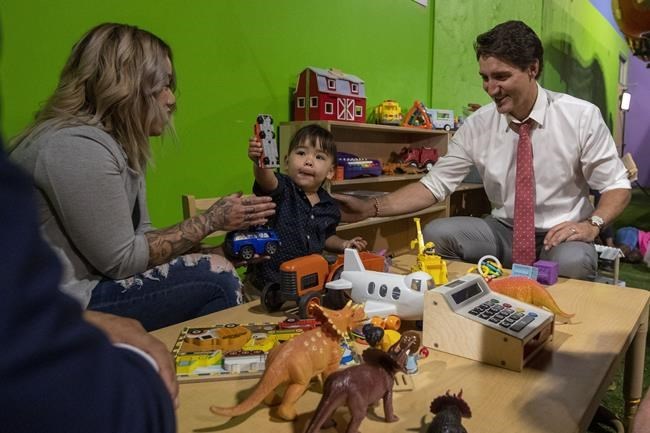OTTAWA ŌĆö The sa╣·╝╩┤½├Į Child Benefit is being hailed for lifting children out of poverty seven years since its introduction, as families get a cost-of-living boost this month.┬Ā
Families eligible for the sa╣·╝╩┤½├Į Child Benefit are getting their July payments Thursday, and they include a hefty cost-of-living adjustment.
Most federal benefits and credits increased by 6.3 per cent this month to reflect the pace of inflation in the previous year.┬Ā
That means families can receive an annual total of up to $7,437 per child under the age of six and $6,275 per child ages six through 17.
The Liberals are highlighting the sa╣·╝╩┤½├Į Child Benefit to mark its seven-year anniversary after they introduced it in their first budget.
Prime Minister Justin Trudeau was in southeastern Ontario on Thursdayspeaking to families about the impact of the benefit, which he said has reduced poverty across the country.
"Seven years ago we brought in the sa╣·╝╩┤½├Į child benefit," Trudeau told reporters while visiting a Boys and Girls Club location in Kingston, Ont.┬Ā
"It has impacted families from coast to coast to coast with hundreds of dollars, tax free, every single month to help with the high costs of raising kids."
In 2021, 7.4 per cent of Canadians lived in poverty, down from 12.9 per cent in 2016 when the benefit came into place.
Robert Asselin, who served as the policy and budget director for former finance minister Bill Morneau, hailed the success of the benefit and called it the "signature policy" of the Liberals' 2015 election campaign.
The sa╣·╝╩┤½├Į Child Benefit replaced the Universal Child Care Benefit, which was in place under former prime minister Stephen Harper's government.┬Ā
A key difference between the two payments is that the Harper-era version was a taxable benefit that all families were eligible for, regardless of their income.
Asselin, who is now the senior vice-president of policy at the Business Council of sa╣·╝╩┤½├Į, said the decision to make the updated benefit means-tested meant that it was better targeted to families who need it most.┬Ā
"The decision was made to cut off the benefits for people who earn over a certain threshold," Asselin said.┬Ā
"And, you know, I think credit (goes) to the prime minister, who went with it. And I think that as a result it had a much bigger impact because it was focused on people who needed it."
According to the sa╣·╝╩┤½├Į Revenue Agency, the benefit gradually decreases when the adjusted family net income is over $34,863.
In an interview, Families Minister Karina Gould touted the positive effects of the benefit, attributing the success in poverty reduction to the fact that the payments are targeted and income-tested.┬Ā
"We have really, I think, introduced something that can teach every level of government meaningful lessons about how to lift people out of poverty, to design a benefit that makes a difference and then has a real impact on families," Gould said.
Jennifer Robson, an associate professor of political management at Carleton University, said it's hard to prove that the CCB is fully responsible for the reduction of poverty in the country.
But a look at the data shows child poverty rates declined more sharply after the benefit came into place, she said.
Robson said the "intensity" of poverty was also reduced. That means the average gap between the low-income threshold and the household income of children living in poverty, after taxes and transfers, has shrunk.┬Ā
But Robson said there is room for improvement, as low-income children are on average still about 25 per cent below the threshold.
"The CCB has probably done a lot of good for kids in lower-income families nearer to the poverty line to pull them over the threshold," Robson said in an email.
"But for those in deeper poverty, the benefit probably isn't yet big enough to lift them up and over the same hurdle."
Addressing that issue would be challenging, Robson said, given it would be expensive to improve the benefit for low-income families without reducing the number of children who receive it or the rate at which the benefit's value declines with income. ┬Ā
She said there are other ways to improve on the success of the CCB, including indexing the benefit more frequently to make the payments more closely reflect the cost of living in real time.┬Ā
Some parents are also missing out on the benefit, she said, because they don't file their taxes.┬Ā
On a larger scale, though, Robson praised the effort to make life more affordable for those who want to have children.
"Making sa╣·╝╩┤½├Į an affordable place to have kids is, in my view, just good economic policy. The CCB is part of that."
This report by The Canadian Press was first published July 20, 2023.┬Ā
Nojoud Al Mallees, The Canadian Press



